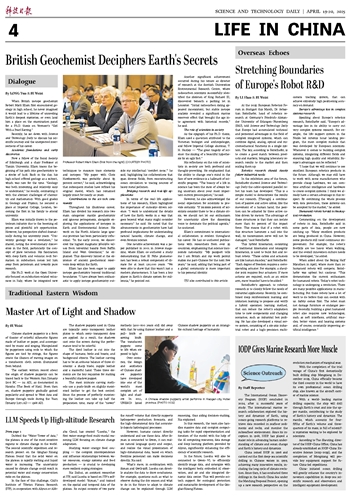
At the 2025 European Robotics Forum in Stuttgart this March, Dr. Sebastian Reitelhofer, head of robotics research at Germany's Friedrich-Alexander University of Erlangen-Nuremberg (FAU), told Science and Technology Daily that Europe had accumulated technical and personnel advantages in the field of complex integrated systems, which can combine digital, analog, optical and micromechanical functions in a single system. The key, according to Reitelhofer, is to create a good match between products and markets, bringing laboratory research results to the market and then scaling them up.
Robotics research should closely follow industrial needs
In the exhibition area of the forum, Reitelhofer showed Science and Technology Daily the cable-operated parallel robot his team has developed. "This is a simple model to demonstrate the results of our research. [Through] a combination of passive and active cables, like the movement of a human hand, the position can be adjusted by three active cables driven by motors. The advantage of these structures is that they can isolate more than 80 percent of the impact force. This means that if a robot with this structure hammers a nail into the wall, its transmission servo will not be damaged," said Reitelhofer.
This hybrid kinematics, consisting of traditional kinematics and tensegrity kinematics, is used to build fast and robust robots. "These cables and actuators are like human muscles," said Reitelhofer. "Each degree of freedom requires a corresponding actuator. For example, a shoulder joint requires four actuators. If more actions are required, such as an entire arm, more 'muscles' have to be added."
Reitelhofer's approach to robotics research is to closely follow the needs of industrial applications. Recently, he combined deep reinforcement learning and imitation learning to propose and verify a hybrid operation learning method, that can reduce the robot's adaptation time to new components and changing scenarios, such as industrial box picking. He has also developed a visual servo system, consisting of a six-axis industrial robot and a high-precision multi-camera tracking system, that can achieve extremely high positioning accuracy on demand.
Europe's advantage lies in complex systems research
Speaking about Europe's robotics research, Reitelhofer said, "Europe's advantage lies in its ability to carry out very complex systems research. For example, the life-support system in the NASA-led Artemis lunar landing program, the most complex module that was developed by European scientists. Whenever it comes to building complex systems, integrating different fields and ensuring high quality and reliability, Europe's advantages can be reflected."
"I hope that we will continue to see excellent European robotics products in the future. Although we may still have to work with some manufacturers who provide cheap hardware, we can combine artificial intelligence and hardware to create complex systems. I think we already have a certain advantage in this respect. By combining the whole process with data protection, these systems can be accepted by the market," he added.
Humanoid robots herald technological revolution
Commenting on the development of robots in Asia, Reitelhofer said in some parts of Asia, people are now catching up. "Many excellent products are being produced in China. However, some products still need continuous improvement. For example, the robot's footfalls are too heavy when walking, and the overall innovation culture needs to be developed," he added.
When asked about the Beijing Half Marathon in April, where more than 20 humanoid robots will compete, Reitelhofer was upbeat but cautious. "This demonstrates the current enthusiasm for humanoid robots. Today's robot technology is undergoing a revolution. There are many possible applications in manufacturing. But these robots have a lot of work to do before they can coexist with us. Safety comes first. The robot must not damage furniture or endanger people. Secondly, building a great humanoid robot also requires new technologies, such as soft interfaces, artificial muscles, better vision and hearing systems and, of course, constantly improving artificial intelligence."







